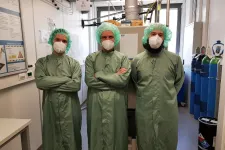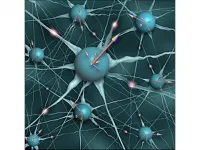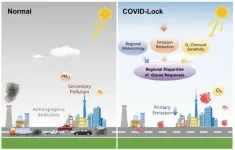(Press-News.org) In certain materials, electrical and mechanical effects are closely linked: for example, the material may change its shape when an electrical field is applied or, conversely, an electrical field may be created when the material is deformed. Such electromechanically active materials are very important for many technical applications.
Usually, such materials are special, inorganic crystals, which are hard and brittle. For this reason, so-called ferroelectric polymers are now being used. They are characterised by the fact that their polymer chains exist simultaneously in two different microstructures: some areas are strongly ordered (crystalline), while disordered (amorphous) areas form in between. These semicrystalline composites are electromechanically active and therefore combine electrical and mechanical effects, but at the same time they are also flexible and soft. At TU Wien, such materials have now been studied in detail - with surprising results: above a certain temperature, the properties change dramatically. A research team from TU Wien in cooperation with research groups from Madrid and London has now been able to explain why this happens.
From micro-sensors to smart textiles
"If you can control the mechanical behaviour of a material with the help of electric fields, you can use it to build tiny sensors, for example," says Prof. Ulrich Schmid from the Institute of Sensor and Actuator Systems at TU Wien. "This is also interesting for atomic force microscopes, where you set a tiny tip in vibration to scan a surface and generate an image."
The field of application of such materials can be expanded dramatically if it is possible to induce such electromechanical properties not only in rigid materials, but also in flexible, soft materials. On the one hand, flexible materials have a completely different vibration behaviour, which can be exploited in the construction of tiny sensors. On the other hand, such materials also open up completely new possibilities - such as smart textiles, flexible energy storage or for integrated energy harvesting.
"Solids can be crystalline, in which case the atoms are arranged in a regular lattice, or they can be amorphous, in which case the individual atoms are randomly distributed," explains Jonas Hafner, who is working on this research project as part of his dissertation. "The special thing about the material we studied is that it can be both at the same time: It forms crystalline regions, and in between the material is amorphous."
The crystals are responsible for the electromechanical properties of the material, the amorphous matrix holds the tiny crystals together, overall creating a very soft, flexible material.
Too much heat
In order to be able to further develop and improve such materials, the research team first investigated their basic physical properties. During their investigations, they came across a surprising phenomenon: the ferroelectric polymers, which consist of a combination of crystalline and amorphous areas, change their microscopic composition at a certain temperature - which has surprising effects on the macroscopic electromechanical behaviour.
Normally, the electromechanical properties of a material only disappear when a very high temperature causes such large oscillations at the atomic level, that the electrical order in the material disappears completely. This critical temperature is called the "Curie temperature". But in the case of the material now being studied, things are more complicated: "In our case, the electromechanical properties of the tiny crystals remain. Microscopically, the crystals are still electroactive, but on the macroscopic level, this electroactive behaviour disappears," says Jonas Hafner.
Lost contact between the crystal grains
The team was able to explain how this effect occurs: As the temperature rises, the proportion of amorphous areas of the polymer increases, and at a certain point the tiny crystals lose direct contact among each other. This means that mechanical forces can no longer be transferred from one of the tiny crystals to the next, because they are all completely embedded in a damping amorphous matrix. This dramatically changes the mechanical and electromechanical behaviour of the material.
"Only if we understand these fundamental effects we can explain how microscopic and macroscopic properties correlate in such materials," says Ulrich Schmid. "We are working with numerous project partners who then use such materials - in atomic force microscopes, in sensors, in chips. There are numerous potential applications for this exciting material phase."
INFORMATION:
Contact
Prof. Ulrich Schmid
Institut für Sensor- und Aktuatorsysteme
TU Wien
Gußhausstraße 27-29, 1040 Vienna
+43 1 58801 36689
ulrich.e366.schmid@tuwien.ac.at
A study has described genetic changes in patients with the most common form of hereditary kidney disease that affects an estimated 12.5 million people worldwide. The research, which focussed on Polycystic Kidney Disease (PKD) in Ireland, provides insights into PKD that will assist doctors and patients in the management of this of inherited condition.
The study, led by researchers from the RCSI University of Medicine and Health Sciences, is published in the European Journal of Human Genetics.
In the research, a cohort of 169 patients with PKD in Ireland were analysed. The genetic changes were identified in up ...
Results from a new study which draws on survey data collected during the peak of the first wave of the pandemic suggests that being forced to slow down life, as a consequence of lockdown, has had significant, positive impacts for many people and their families.
The research, recently published in the British Journal of Psychiatry from a team at the University of Bath with international colleagues, analysed survey results from 385 caregivers of children aged 6-16 both in the UK and Portugal. Individuals completed an online questionnaire between 1 May 2020 and 27 June 2020.
This cohort had ...
Swapping the car for walking, cycling and e-biking even just one day a week makes a significant impact on personal carbon emissions in cities.
'Active transport' - cycling, e-biking or walking - can help tackle the climate crisis according to a new study led by the University of Oxford's Transport Studies Unit and including researchers from Imperial's Centre for Environmental Policy as part of the EU-funded project PASTA: Physical Activity Through Sustainable Transport Approaches.
Meeting greenhouse gas emissions reduction targets requires a significant move away from motorised transport. The team found that shifting to active transport could save as ...
Molecular iodine, a major emission from the ocean, can quickly convert to iodic oxoacids even under weak daylight conditions. These oxoacids lead rapidly to aerosol particles that significantly affect climate and human health.
Iodine-containing vapors that are emitted from oceans are a major source of aerosol particles. "Despite their importance to the climate, the formation of marine particles has been poorly understood," says Siddharth Iyer, Postdoctoral Researcher in Aerosol Physics Laboratory at Tampere University.
In this research, the formation of aerosol particles form from iodine-containing vapours under marine boundary layer conditions were studied. The experiments were carried out in the ultra-clean CLOUD chamber in CERN, where the nucleation and growth rates as well as ...
Cells, like humans, cast votes to make decisions as a group. But how do they know what to vote for? Researchers at the Francis Crick Institute and King's College London have uncovered how cells actively seek information in order to make faster and better collective decisions to coordinate the growth of new blood vessels. This provides a new basis for understanding intelligence in cells.
The process of how cells precisely and quickly coordinate action when they create new tissue is complex. They must collectively decide which cells should take on specific jobs and ensure that not too ...
Is a quantum machine really more efficient than a conventional machine for performing calculations? Demonstrating this 'advantage' experimentally is particularly complex and a major research challenge around the world1. Scientists from the CNRS2, the University of Edinburgh (Scotland) and the QC Ware, Corp., (France and USA) have just proved that a quantum machine can perform a given verification task in seconds when the same exercise would take a time equivalent to the age of the universe for a conventional computer. For this demonstration, they combined a complex interactive algorithm that solves a certain type of mathematical problem with limited information and a simple experimental photonics ...
Goal 7 of the Sustainable Development Goals (SDGs) aims to ensure access to affordable, reliable, sustainable and modern energy for all by 2030. Yet according to new research by Copenhagen Business School the poor planning and execution of decarbonisation strategies in emerging markets challenges the aims of Goal 7.
"In the effort to produce renewable energy and decarbonise their economies, emerging countries have neglected the effect on marginalised populations, which could ultimately prove unsustainable for all," says Assistant Professor Jacobo Ramirez from the ...
An important class of challenging computational problems, with applications in graph theory, neural networks, artificial intelligence and error-correcting codes can be solved by multiplying light signals, according to researchers from the University of Cambridge and Skolkovo Institute of Science and Technology in Russia.
In a paper published in the journal Physical Review Letters, they propose a new type of computation that could revolutionise analogue computing by dramatically reducing the number of light signals needed while simplifying the search for the best mathematical solutions, allowing for ultra-fast optical computers.
Optical or ...
A way of using machine learning to more accurately identify patients with a mix of psychotic and depressive symptoms has been developed by researchers at the University of Birmingham.
Patients with depression or psychosis rarely experience symptoms of purely one or the other illness. Historically, this has meant that mental health clinicians give a diagnosis of a 'primary' illness, but with secondary symptoms. Making an accurate diagnosis is a big challenge for clinicians and diagnoses often do not accurately reflect the complexity of individual experience or indeed neurobiology.
Clinicians diagnosing psychosis, for example, would frequently regard depression as a secondary illness, with implications for treatment decisions which focus more on ...
The outbreak of COVID-19 raised a question about the relationship between anthropogenic emissions and air pollution, which has aroused heated discussion. Research on air-quality changes caused by the lockdowns in different areas shows similar substantial reductions in primary emissions. However, regional disparities exist in responses of secondary pollutants to emissions reduction, especially fine particulate matter and ozone (O3).
Professor Ding Aijun and his team from Nanjing University explored global air-quality changes during COVID-19 lockdowns and regional disparities in O3 responses to emission reductions. They integrated multiple observational datasets, including global air quality ...



